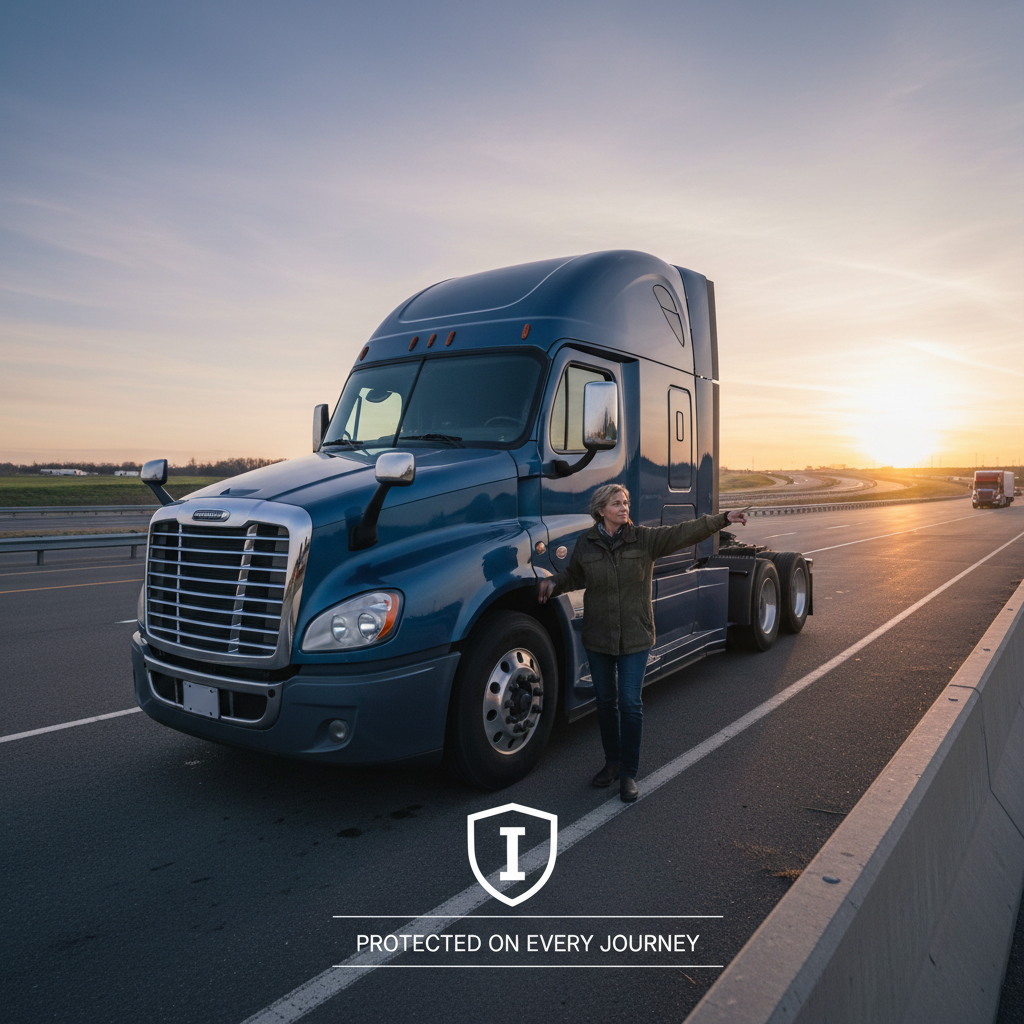Learn how to choose the right commercial trucking insurance in 2025. Explore coverage types, cost drivers, money saving tactics, and market trends to safeguard your fleet and business.
Introduction
The roar of the engine, the asphalt stretching to the horizon, and the responsibility of moving goods across the country—this is life on the road for trucking professionals. But a single accident, theft, or liability claim can jeopardize everything you’ve built. That’s why commercial trucking insurance isn’t just a line item in your budget; it’s the backbone of your business’s resilience.
Whether you’re an owner-operator, the manager of a growing fleet, or a business reliant on commercial vehicles to deliver goods, this guide gives you the insight you need to protect your assets, minimize risk, and navigate the shifting insurance landscape of 2025.
What Is Commercial Trucking Insurance — And Why It’s Different
Commercial trucking insurance is a suite of policies designed to address the unique risks of hauling freight, managing drivers, and operating large vehicles. Unlike personal auto insurance, trucking insurance must consider higher liability exposures, complex regulations, cargo damage, and multiple types of risk.
- Vehicle scale and repair cost: A wreck involving a heavy-duty truck can lead to catastrophic repair bills, medical claims, and legal liabilities well beyond typical auto limits.
- Complex liability landscape: Policies must anticipate damage to others, cargo, third-party injury, and environmental or hazardous materials exposures.
- Regulatory requirements: Many jurisdictions and the FMCSA (Federal Motor Carrier Safety Administration) demand minimum coverages for commercial hauling operations.
Who Needs Commercial Trucking Insurance? Profiles & Use Cases
| Profile | Why They Need It | Key Considerations |
|---|---|---|
| Owner-Operators | Your truck is your business. Without coverage, one major claim can bankrupt you. | Select appropriate cargo protection, non-trucking liability, and physical damage cover. |
| Small Fleets | More trucks = more exposure. One claim can ripple across your whole operation. | Uniform safety programs, consistent driver vetting, and scaled discounts matter. |
| For-Hire Carriers / Brokers | Many clients require proof of robust insurance limits before awarding contracts. | Maintain policies that meet or exceed client and state/federal minimums. |
| Businesses with Trucks (Construction, Logistics, Distribution) | Your trucks support core operations. A breakdown or liability event can stall your business. | Tailor insurance to your usage (e.g. local delivery, interstate haul, heavy goods). |
The 5 Pillars of Risk Protection Your Policy Should Deliver
- Legal & Regulatory Compliance: Operating without required liability coverages can lead to fines, authority suspension, or grounding of your fleet.
- Financial Buffer Against Catastrophic Loss: Accidents, lawsuits, or cargo loss can cost hundreds of thousands or more. Adequate insurance turns potential disaster into a managed event.
- Asset & Brand Protection: Physical damage protects your trucks; cargo coverage upholds client trust. Damage to freight can erode relationships faster than the cost itself.
- Operational Continuity: The quicker you repair, replace, or litigate, the sooner you're back on the road—and generating revenue again.
- Credibility & Contract Access: Many shippers, brokers, and governmental contracts require insurance above standard limits. A robust policy becomes a competitive advantage.
Core Coverages in a Commercial Trucking Policy
- Primary Liability / Auto Liability: Covers bodily injury or property damage you cause to others.
- Physical Damage (Collision, Comprehensive): Repairs or replaces your truck after collisions, theft, vandalism, or weather events.
- Motor Truck Cargo Insurance: Covers damage or loss to the freight you haul.
- General Liability: Protects against risks outside driving, like slips at loading docks, property damage, or advertising liability claims.
- Non-Trucking Liability: Covers leased-on truckers for accidents that occur when their truck is being used for personal reasons.
Watch Our Top Tips
2025 Market Trends & Forces Shaping Trucking Insurance
Understanding current dynamics helps you negotiate smarter and anticipate cost shifts.
A. Rate Pressure & Hard Market Conditions
- Premiums remain under upward pressure. Commercial auto and liability lines are still seeing double-digit growth in some markets.
- In Q1 2025, commercial insurance rates rose ~5.3% overall—though this is a moderating increase compared to previous quarters.
- Lines like umbrella or excess liability remain especially hard-hit due to litigation risk and “nuclear verdicts.”
B. Litigation Risk, Social Inflation & Verdicts
- Rising jury awards, broader liability definitions, and litigation funding are driving up claim severity.
- The trucking industry is a prime target for large verdicts due to the scale of potential damage in accidents.
C. Repair & Replacement Cost Inflation
- Supply chain constraints, rising parts cost, and labor shortages are driving up physical damage repair costs.
- These higher costs feed back into increased premiums.
D. Cargo Theft & Supply Chain Risks
- Cargo theft is trending upward—particularly in high-value freight like electronics, metals, and packaged food.
- Supply chain disruptions, delays, and demand volatility add risk layers insurers watch closely.
E. Technological & Underwriting Innovation
- Insurers are leaning into data, telematics, and AI to better assess risk and price more dynamically.
- Use-based underwriting, ADAS (Advanced Driver Assistance Systems), driver behavior scoring, and real-time monitoring can unlock discounts.
- Fleets that embrace these systems early may gain competitive advantage in pricing and risk negotiation.
F. Regulatory & Environmental Shifts
- Emissions and sustainability mandates are evolving—increasing pressure on fleets to adopt cleaner technologies.
- Noncompliance risk or changes in vehicle standards may influence underwriting criteria in coming years.
How Much Does It Cost? Real 2025 Premium Ranges & Cost Drivers
- Owner-operators are reporting $11,000 to $16,000+ annually for liability and cargo in many regions, depending on coverage, route, and risk profile.
- Insurance costs per mile are rising. ATRI reports trucking insurance costs rising to ~$0.099 per mile (reflecting ~12.5% year-over-year increase).
- Fleets with many units may have lower per-unit premiums but face cumulative exposure.
- Drivers with clean records, safety programs, modern equipment, and telematics may unlock meaningful discounts.
How to Identify the Right Rate — Smart Comparison Strategy
- Use a Broker or Insurance Specialist (like Logrock): A broker with trucking specialization can access niche carriers and negotiate terms suited to your profile.
- Standardize Quote Comparisons: When reviewing quotes, ensure identical liability limits, deductibles, coverage windows, and exclusions.
- Highlight Safety & Technology Measures: Document telemetry, dashcams, driver training, inspection programs—these bolster your risk profile.
- Refine Operational Inputs: Submit accurate mileage, route radius, cargo type, and percentage of empty journeys to avoid mispricing.
- Challenge Exclusions & Price Assumptions: Ask for written assumptions behind pricing; sometimes “exclusion creep” or unfavorable terms hide extra costs.
Proven Strategies to Reduce Premiums (Smart, Safe, Sustainable)
- Maintain clean driver records — accidents, violations, and claims history are heavily penalized.
- Incentivize safety behavior — training, monitoring, reward programs, and accountability reduce risk.
- Invest in telematics, dashcams & ADAS systems — insurers reward measurable behavior data.
- Raise deductibles carefully — increases premium exposure but can reduce premium if done thoughtfully.
- Review & trim unnecessary or redundant coverage — don’t pay for coverage that doesn’t serve your routes or operations.
- Bundle multiple lines intelligently — liability, cargo, physical damage, umbrella—bundles sometimes reduce administrative overhead.
- Negotiate multi-year or locked renewals — carriers sometimes offer stability deals to predictable, low-loss clients.
- Strengthen claims management & documentation — swift, well-documented claims reduce loss severity and insurer distrust.
- Improve fleet quality & maintenance — newer, well-maintained trucks are less risky.
- Manage exposure & routes — reduce high-risk routes, avoid areas with high theft or litigation exposure.
Frequently Asked Questions
Commercial trucking insurance covers liability (injury/property), physical damage, cargo, general liability, non-trucking liability, and optionally excess limits.
Costs vary widely, but many one-truck operations are paying $11,000–$16,000+ annually. Industry data suggests ~$0.099 per mile in current cost models.
Yes — fleets that adopt telematics, driver scoring, dashcams, and ADAS systems often qualify for discounts because insurers gain better insight into risk behavior.
Primary reasons include social inflation, rising litigation and verdicts, repair cost inflation, cargo theft, and tightened underwriting in a hard market.
Work with a trucking-specialized broker, standardize quote comparisons, pitch your safety and technology measures, optimize your coverage design, and review renewal assumptions annually.




